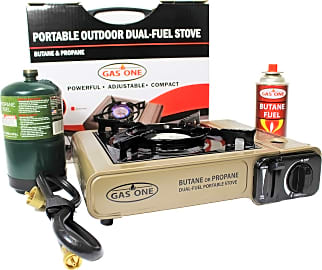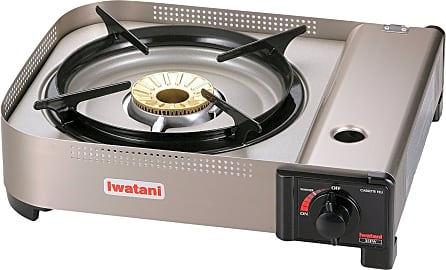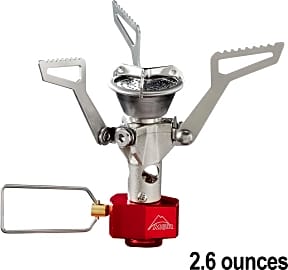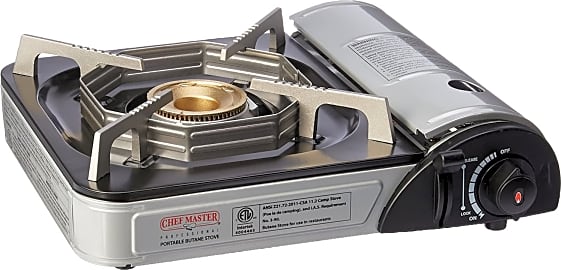The 10 Best Butane Stoves

This wiki has been updated 35 times since it was first published in April of 2016. Offering a few subtle advantages over their propane counterparts, including longer burning times and easier connections, butane stoves are a great alternative solution to the problem of cooking outdoors. But the models in this selection aren't just for camping; they can also serve as gas hot plates for catering outdoor events, like weddings, providing you follow all the safety protocols. When users buy our independently chosen editorial choices, we may earn commissions to help fund the Wiki.
Editor's Notes
July 15, 2021:
We're extremely confident that our selection is still every bit as good as last time around, aside from one Camp Chef model with poor availability. In its place is the Chef-Master 90011, which is a remarkable value and comes in a rigid blow-molded carrying case. Despite its low price, it's very well made and promises to use every last drop of fuel in the canister. As for our remaining options, the Gas One GS-4000P is the all-around single-burner winner and the Gas One GS-2000 Twin Fuel the most versatile dual-burner model.
August 07, 2020:
There are a few classes of butane stove, from the highly portable backpacking models like the Etekcity Ultralight Portable and MSR PocketRocket 2, and for these to be most effective you'll have to purchase the appropriate size and blend of fuel canister. The Camp Chef Mountain Series and Coleman Instastart are of moderate quality and reasonable prices, so they're good for casual use.
If you're really interested in performance and safety, though, you might want to step up to the Gas One GS-4000P or, if you need two burners, the Gas One GS-2000 Twin Fuel, and if you don't want to be limited to strictly butane, consider the Gas One GS-3400P Dual Fuel. Then there's the GasOne GS-8300, which wasn't meant for backpacking but is considerably more compact than most of its competition.
Iwatu make some of the most premium options on the market, though, and you'll be able to tell as soon as you start using the Iwatani 35FW or Iwatani ZA-3HP. These offer especially reliable components including dependable igniters, easily cleaned surfaces, powerful output, and long lifespans. Also keep in mind that butane has a limited operating temperature range when compared to some other fuels, so if you'll be camping out in very col weather, you'll need to take an appropriate stove.
April 16, 2019:
Butane stoves serve a a couple different purposes. You'll see them at campgrounds relatively often because they're generally lighter and smaller than propane stoves, and you'll see them at outdoor catering events because they're easy to set up and don't produce much of a smell. You'll also find some particularly tiny versions that are meant for backpacking through the wilderness. Of these, the ETekCity is the least expensive, and it works quite well for such a straightforward item. The MSR PocketRocket 2 is a well-known item among hardcore ultralight fanatics, and while it's about three times the cost of the ETekCity, it's only about one-third of the weight. Both of these are relatively specialized pieces of equipment, though, and where you won't see them is at a family campout.
Speaking of family gatherings, if you're cooking for a group, or if you just plan on cooking more than one thing at once, it's hard to beat the Gas One GS-2000. Like most of their offerings, it also burns propane cleanly, which makes them a little more economical. The GS-2000 is one of the few with two burners, which is what sets it apart. The GS-3400P puts out a little bit more heat, while the GS-4000P is near the top of the category in BTUs, with 12,000, and it is overall designed for more consistent operation. It even has a thermal conductor plate that keeps your butane canisters warm, which keeps them from shutting off before they're empty in cold water (you can thank the physical characteristics of butane for that). Iwatani also makes a couple excellent models in the middle and high price ranges. But if you're on a tight budget, the Coleman, Sterno, and Camp Chef are worth looking at. As long as you pay close attention to them and exercise a little more care, they can perform perfectly well, and they don't cost a whole lot.
Whichever you choose, never leave open flames unattended, and be very careful with any and all cooking implements that you may be using. Whether you're at a sanctioned state campground or deep in the backwoods, safety is always the number one priority.
Cooking Convenience with a Butane Stove
What butane stoves offer over purpose-built camp stoves is heat output nearly comparable to the burner of a traditional range stovetop.
Butane stoves are elegantly simple devices. They are little more than square frames designed to house an inserted fuel canister that can create an easily-regulated flame. At a glance, the top of these stoves looks much like the burner of the same gas-fueled stove found in many homes, with one marked difference: a butane stove can be setup on a picnic table, on a boat's deck, or on a slab of rock dozens of miles out into the backwoods.
Before weighing the benefits of these stoves at length and discussing who might benefit from their ownership, it is only fair to make clear that in most cases, apparent ease of portability notwithstanding, a butane stove is not an ideal camping tool -- at least not for the overland hiker who must carry all of his or her gear in a pack. Most of these units weigh an average of five pounds even before their fuel canisters are added, while most true camping stoves weigh mere ounces. (If you can park near your campsite or are traveling by canoe, snowmobile, or another conveyance, then by all means choose a butane burner.)
What butane stoves offer over purpose-built camp stoves is heat output nearly comparable to the burner of a traditional range stovetop. For all the convenience an extra-lightweight, compact, and collapsible stove may offer, few such units can come anywhere close to creating the same BTUs as a chef enjoys when cooking at home. Some options can even offer a 15,000 BTU flame at their highest setting, which is in fact double the capacity of many stovetop burners. (Most residential stove burners are rated at between 7,000 to 10,000 BTUs for reference.) Most options offer output closer to 10,000 BTUs, which is still enough heat to bring large pots to a boil or create a fast sear in a pan. Butane stoves also feature built-in ignition systems (most use an electric spark) that eliminate the need for a lighter or match; this adds safety, convenience, and reliability.
Once you are convinced that a butane stove will generally suit your needs, start your search for a specific unit by considering price range. At the top of the price spectrum you will find attributes including detachable wind shields and high-powered heat output as previously discussed. What any decent butane stove will offer is safety features such as an automatic shutoff and an easy flame adjustment control dial. Also look for burners that come with hard-walled cases, as even the most durable device can be easily damaged if not stored properly during transport.
Ideal Uses for Butane Stoves
While a butane stove might not be the ideal choice for the mountaineer trekking over miles of trails at high elevation, it's an ideal appliance for the car camper, the fisherman, for use at a cabin, and for any other outdoor activities that tend to preclude access to the gear with which we're comfortable in our kitchen.
Butane stoves were not, however, designed specifically to be used by outdoorsman at all.
Butane stoves were not, however, designed specifically to be used by outdoorsman at all. In fact, they are at their best when used as part of a more comprehensive cooking setup such as one might find at a catered event, a restaurant with an outdoor section, or at a cooking demonstration. Because a single butane stove can effectively replace the burner of a fine stovetop, with several such units working in concert, a chef can recreate the function and convenience of a standard kitchen anywhere.
Common uses for these stoves include omelet/breakfast stations such as one might find at a hotel or ski lodge where short order foods are custom-prepared for each guest. So too can a butane stove help a cook prepare batches of fried foods ranging from potatoes to clams to various cuts of meat. A decent butane stove can also be used to keep large pots of soups or stews hot, providing more warmth than a traditional chafing dish heater could ever muster.
And for the cook who plans a live demonstration of various recipes or techniques, it's imperative that she have at her disposal a cooktop with the same abilities of that which she used to design the meal. The built-in ignition and reliable flame output of a butane stove helps to ensure a demo will be a success; the safety and reliability offered by these units will also be welcome to the chef working in front of an audience, cameras, or both.
A Few Words On Butane Stove Safety
If there is only one safety tip you heed when it comes to using a butane stove, let it be this one: don't use one of these devices inside. While these devices are not necessarily designed to be used only in the outdoors, their safe use requires excellent ventilation. In general, use in the home should be avoided, and they should never be switched on in confined spaces like a tent, a camper, or a cabin. A butane stove can safely be operated in interiors with plentiful ventilation, such as you will find in most commercial spaces.
While these devices are not necessarily designed to be used only in the outdoors, their safe use requires excellent ventilation.
If you must use your butane stove inside, open windows and run air circulation systems to the fullest extent possible. To ensure your safety, also consider installing a carbon monoxide monitor nearby your cooking area; with those steps taken, you can count on a benign cooking experience indoors. Just be sure to shut the stove off whenever you are not actively using it to minimize the levels of potentially hazardous gasses that build up.
While a standard range stovetop creates potentially dangerous flames and heat, it is fixed in place and predictable. Butane burners, on the other hand, can be knocked to the ground or inadvertently bumped too close to a flammable material, such as a tablecloth, curtain, or another surface or item. Take care to place your stove somewhere safe and to make sure all those in the area know where it is and when it is being used.
While most butane stoves have safety features that will cut their flame output if the stove is turned over or even tilted to too much of angle, keep in mind that even after the active burn is over, the top of the burner can still be hot enough to cause a previous injury or to ignite a flammable material.















